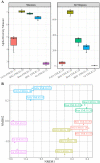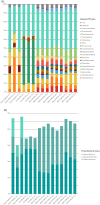Diversity and dynamics of bacteria from iron-rich microbial mats and colonizers in the Mediterranean Sea (EMSO-Western Ligurian Sea Observatory): Focus on Zetaproteobacteria
- PMID: 39008445
- PMCID: PMC11249232
- DOI: 10.1371/journal.pone.0305626
Diversity and dynamics of bacteria from iron-rich microbial mats and colonizers in the Mediterranean Sea (EMSO-Western Ligurian Sea Observatory): Focus on Zetaproteobacteria
Abstract
Autotrophic microaerophilic iron-oxidizing Zetaproteobacteria seem to play an important role in mineral weathering and metal corrosion in different environments. Here, we compare the bacterial and zetaproteobacterial communities of a mature iron-rich mat together with in situ incubations of different Fe-bearing materials at the EMSO-Ligure West seafloor observatory, which is located on the abyssal plain in the NW Mediterranean Sea. Our results on bacterial communities enable us to make a clear distinction between those growing on mild steel anthropic substrata and those developing on basaltic substrata. Moreover, on anthropic substrata we highlight an influence of mat age on the bacterial communities. Regarding zetaproteobacterial communities, our results point to an increase in ZetaOTUs abundance and diversification with the age of the mat. We corroborate the key role of the ZetaOTU 2 in mat construction, whatever the environment, the substrata on which they develop or the age of the mat. We also show that ZetaOTU 28 is specific to anthropogenic substrata. Finally, we demonstrate the advantage of using dPCR to precisely quantify very low abundant targets, as Zetaproteobacteria on our colonizers. Our study, also, allows to enrich our knowledge on the biogeography of Zetaproteobacteria, by adding new information on this class and their role in the Mediterranean Sea.
Copyright: © 2024 Astorch-Cardona et al. This is an open access article distributed under the terms of the Creative Commons Attribution License, which permits unrestricted use, distribution, and reproduction in any medium, provided the original author and source are credited.
Conflict of interest statement
The authors have declared that no competing interests exist.
Figures






Similar articles
-
Linking Zetaproteobacterial diversity and substratum type in iron-rich microbial mats from the Lucky Strike hydrothermal field (EMSO-Azores observatory).Appl Environ Microbiol. 2024 Feb 21;90(2):e0204123. doi: 10.1128/aem.02041-23. Epub 2024 Jan 9. Appl Environ Microbiol. 2024. PMID: 38193671 Free PMC article.
-
Comparative Analysis of Microbial Communities in Iron-Dominated Flocculent Mats in Deep-Sea Hydrothermal Environments.Appl Environ Microbiol. 2016 Sep 16;82(19):5741-55. doi: 10.1128/AEM.01151-16. Print 2016 Oct 1. Appl Environ Microbiol. 2016. PMID: 27422841 Free PMC article.
-
Microbial iron mats at the Mid-Atlantic Ridge and evidence that Zetaproteobacteria may be restricted to iron-oxidizing marine systems.PLoS One. 2015 Mar 11;10(3):e0119284. doi: 10.1371/journal.pone.0119284. eCollection 2015. PLoS One. 2015. PMID: 25760332 Free PMC article.
-
Bacterial diversity in Fe-rich hydrothermal sediments at two South Tonga Arc submarine volcanoes.Geobiology. 2010 Dec;8(5):417-32. doi: 10.1111/j.1472-4669.2010.00247.x. Geobiology. 2010. PMID: 20533949
-
Iron-oxidizing bacteria in marine environments: recent progresses and future directions.World J Microbiol Biotechnol. 2018 Jul 4;34(8):110. doi: 10.1007/s11274-018-2491-y. World J Microbiol Biotechnol. 2018. PMID: 29974320 Review.
References
MeSH terms
Substances
LinkOut - more resources
Full Text Sources
Medical

